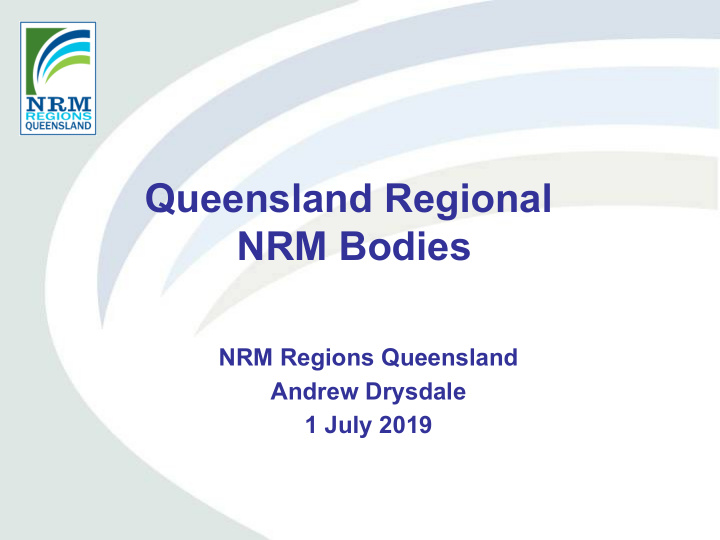



Queensland Regional NRM Bodies NRM Regions Queensland Andrew Drysdale 1 July 2019
Role of the NRM Regions Queensland (NRMRQ) formed in 2002 with the aim of improving state-wide delivery of regional • outcomes in partnership with all stakeholders (including industry, community, research and development organisations and government). Twelve Regional NRM Bodies in Queensland form the NRMRQ’s member base. NRMRQ supports Queensland’s Regional Bodies in the following four areas : Leadership Regional Support and Advocacy Strategic Partnerships Shared Learnings
Torres Strait Boundary Regional Authority map of Cape York NRM Queensland’s Northern Gulf Resource Regional NRM Management Group Terrain NRM Bodies . Southern Gulf Catchments NQ Dry There are a total of Tropics Reef Catchments 54 Regional Bodies Desert Channels Fitzroy Basin across Australia Queensland Association Burnett Mary Regional Group South Queensland Healthy Land and Water NRM
NRM Stakeholders Natural Resource Management Community Natural Resource Management N Landholders, Custodians, Traditjonal Owners a t everyone u r a l R e s o Volunteer Industry Regional Environmental u r Groups Bodies NRM Groups c Groups e QWaLC QFF, AgForce, RGC QCC, WWF M ACS QTIC, QDO a n a g e m e Government n t Local Government / LGAQ, State Government, Australian Government Natural Resource Management
Regional Bodies Role Regional bodies are community based, not-for-profit organisations accredited by the Australian and Queensland governments to plan, fund and implement programs under regional NRM plans. They are the only means by which national, state and local governments are able to partner with land managers and the community to improve the health of the entire natural and productive landscape. Queensland’s community-based Regional NRM bodies work in partnership with the community to look after State’s natural assets, such as soil, water and vegetation and respond to challenges such as climate risk at a regional scale. Regional Bodies build partnerships with a diverse range of stakeholders to: • plan for regional natural resource management; • monitor the health of natural resources and outcomes of collaboration; • mobilise on-ground work; • strengthen partnerships; • provide incentives and • share knowledge.
So where do RBs fit into responding to challenges in the Rangelands? • Good opportunities to work with a wide range of stakeholders at a local, regional and national scale, • Regional NRM Plans as a coordinating mechanism for activities, • NRM influence in Environment and Community support, • Driving and supporting Queensland and Australian Government initiatives
So where does NRM fit into responding to challenges in the Rangelands? NRMRQ and its members have a vision of: • Functioning land and water ecosystems, • Resilient and engaged communities, • Sustainable quality and supply of water resources, • Sustainable land production systems, This will secure Queensland’s sustainable future through stronger community based delivery of natural resource management.
Questions? Ian Heiner, CEO NRM Regions Queensland 0447 953 006 ian@nrmrq.org.au
Recommend
More recommend